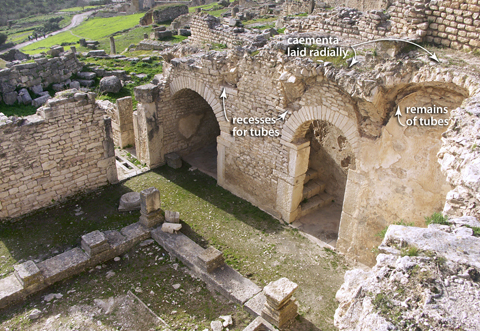Dr. Lynne Lancaster, Professor of Classics & World Religions, published a book on Innovative Vaulting in Architecture of the Roman Empire, 1st to 4th Centuries CE. Cambridge University Press 2015.
 Abstract: This book studies six vaulting techniques employed in architecture outside of Rome and asks why they were invented where they were and how they were disseminated. Most of the techniques involve terracotta elements in various forms, such as regular flat bricks, hollow voussoirs, vaulting tubes, and armchair voussoirs. Each one is traced geographically via GIS mapping, the results of which are analyzed in relation to chronology, geography, and historical context. The most common building type in which the techniques appear is the bath, demonstrating its importance as a catalyst for technological innovation. This book also explores trade networks, the pottery industry, and military movements in relation to building construction, revealing how architectural innovation was influenced by wide ranging cultural factors, many of which stemmed from local influences rather than imperial intervention.
Abstract: This book studies six vaulting techniques employed in architecture outside of Rome and asks why they were invented where they were and how they were disseminated. Most of the techniques involve terracotta elements in various forms, such as regular flat bricks, hollow voussoirs, vaulting tubes, and armchair voussoirs. Each one is traced geographically via GIS mapping, the results of which are analyzed in relation to chronology, geography, and historical context. The most common building type in which the techniques appear is the bath, demonstrating its importance as a catalyst for technological innovation. This book also explores trade networks, the pottery industry, and military movements in relation to building construction, revealing how architectural innovation was influenced by wide ranging cultural factors, many of which stemmed from local influences rather than imperial intervention.
Additional resources, such as the photo above and including extensive searchable databases with bibliographical data and color illustrations, are available at www.cambridge.org/vaulting.
Lancaster also published an article on “Armchair” Voussoir Vaults in Bath Buildings of the Western Roman Empire” in the Proceedings of the 5th International Congress on Construction History, (June 3-7, 2015, Chicago, IL).
Abstract: “This paper examines an unusual method of vault construction that was confined to a series of Roman bath buildings (over 150 examples) in France, Morocco, the Iberian peninsula, and Britain. The vaults were built so that hollow spaces were formed between ribs composed of bricks. This technique is often said to have been used to create heated ceilings in the warm rooms of baths, but, in fact, it was first developed for unheated rooms using only a single slab between the ribs. Rather, the original purpose appears to have been aimed at creating a lightweight, moisture proof vault that could be built with minimum wooden centering. A structural analysis of this vault demonstrates that the structure would not have been stable if roofed with a normal concrete or stone vault, thus implying that, in this case, the technique was used mainly for structural reasons. A chronological study of the development of the technique shows that the early examples (first century CE) were in small public baths in cities of southern France, which was undergoing a period of urbanization beginning under Augustus, but by the second century, the technique was used largely in private villa baths. It seems to have been adopted as a type of prefabricated bath building kit that responded to the desire of wealthy Roman landowners to embellish their countryside villas with small, luxurious bath buildings. Following the development of this one vaulting technique provides insight into both the socio-economic factors leading to its adoption and the ways in which it was adapted to solve constructional, structural, and functional issues. “






















Comments